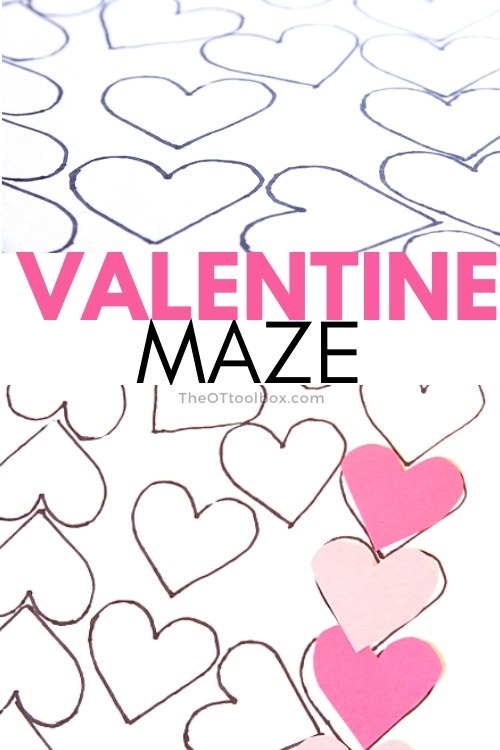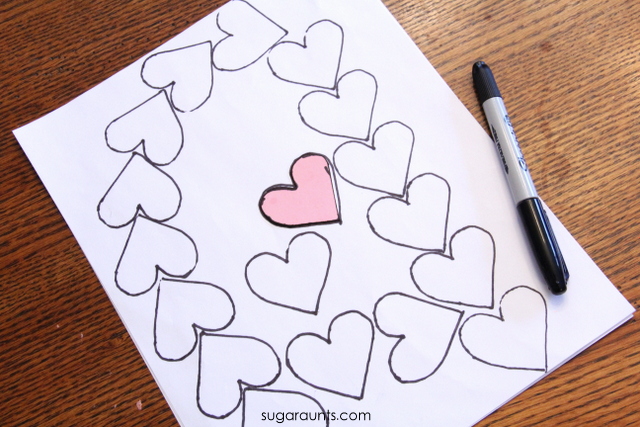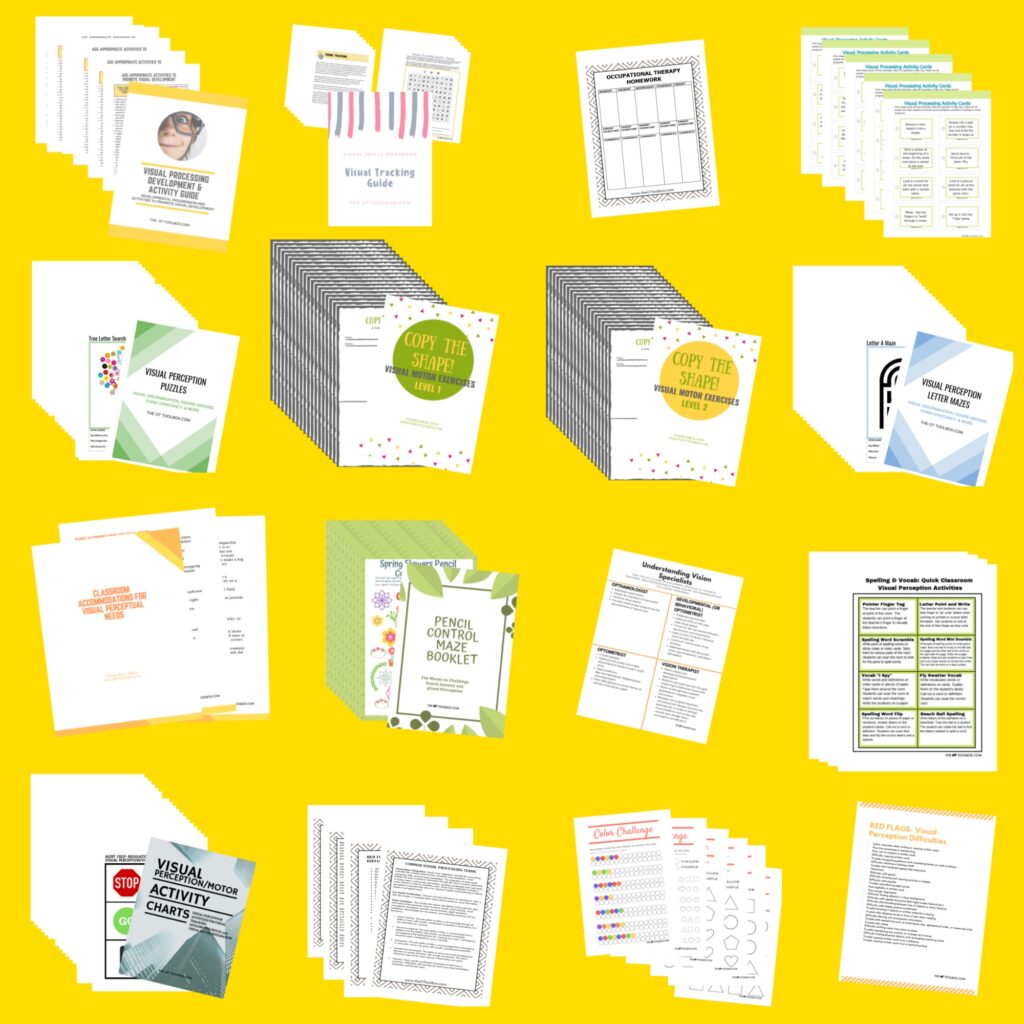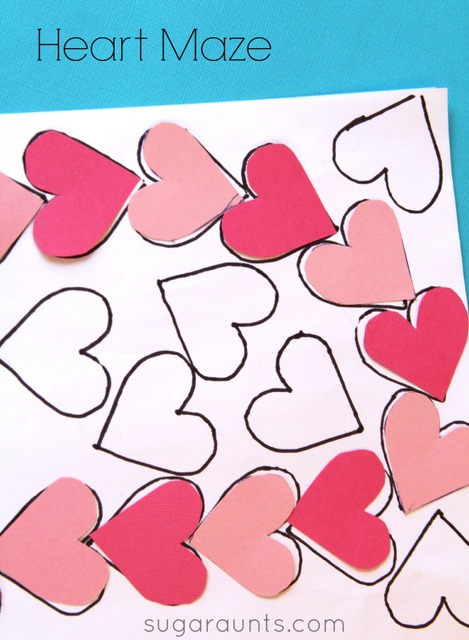This Valentine’s Day maze is an easy DIY visual perception activity that requires only paper and a pencil. Sometimes an activity can be just easy to throw together and the kids love it. This Heart Maze is a simple visual perception activity that can be adapted to any season or shape. We used hearts for a Valentine’s Day occupational therapy activity, while practicing visual scanning, visual spatial relations, line awareness, and eye-hand coordination.
For more Valentine fine motor fun, use these printable Valentine cards for folding, coloring, and cutting.

Valentine’s Day maze activity
This visual perception maze is an easy way to work on visual motor skills needed for tasks like handwriting, reading, and learning. The hearts are placed in a path-like maze that challenges visual perception skills.
Kids can help with making this Valentine’s Day maze, or you can make a template and copy it over and over again. Let’s discuss how this maze works and how it and other visual perception skills helps kids with reading, learning, reading, and writing.
This post contains affiliate links.

How to make a Valentine’s Day Maze
You need just a few materials for this DIY maze, making this a good occupational therapy intervention for teletherapy.
So, grab your materials:
- Paper
- Pencil or marker
- Scissors
We used construction paper to make a heart, but you could use regular paper as well.
It really doesn’t get much easier.
- Draw a small heart. You can use regular paper or colored paper.
2. Using scissors, cut out the heart.
3. Trace the heart on a piece of white paper.
4. Place the point of the heart into the top of the heart so the hearts are connected. Trace the second heart on the paper.
5. Continue tracing, positioning the hearts in a line. You want a “maze” to form around the paper.

6. Fill in the blank space with more heart outlines, but this time, rotate the shape so it’s positioned randomly and not as close to the maze.

Next, you can follow the path of hearts and color them in. You could also place small objects on the hearts, like craft pom poms or mini erasers.
Another option is to use the heart template to cut more hearts from colored paper. We used a darker shade to work on patterns as we filled in the maze. If two shades of colored paper isn’t available, just use two different colored crayons to color in patterns as the child completes the maze.
For children who are working on scissor skills, try using a thicker paper for the heart template. Cardstock is a great option because the thicker paper is resistive and offers proprioceptive feedback through the hands. Here is a link to pink card stock.
For more information on scissor skills and types of paper, try this crash course on scissor skills.

Visual Motor Maze
There are many visual skills being addressed in this occupational therapy maze activity.
Lining up the hearts requires eye-hand coordination to position the card stock hearts within the outlines. Using the hands in a coordinated manner based on visual input is an important skill for many functional tasks including handwriting and scissor use.
This is a great strategy to support visual closure skills needed for reading and writing.
What Are Visual Spatial Relations?
Visual spatial relations is the ability to identify a form/shape/letter despite being rotated, and identify it as being rotated. Children need visual spatial relations to identify the difference between a “b” and “d” and “p”, and “q”.
This sheet full of hearts that look the same requires the child to identify the hearts that are following a path. Some of the hearts not along the path are rotated and the child should be able to identify by scanning, the hearts that are rotated.
Looking for more Visual Perception Activities?
Try these: Smashing Peanuts Activity
Toys to Improve Visual Perception
Tangrams and Visual Perception
Visual Perception Activities

Need help fixing visual processing problems?
Know a student with identified visual processing problems…but difficulties are brushed over or missed in the school setting?
Have a kiddo on your caseload that struggles with visual tracking, fixation, eye teaming, or visual scanning?
Need tools to incorporate visual perception and visual-motor strategies right into the classroom?
Wondering how to help kids who can not visually attend to an object in order to focus for more than a few seconds?
The Visual Processing Bundle is a comprehensive resource on oculomotor skills, visual perception, visual-motor skills.
Details about The Visual Processing Bundle:
- Over 235 pages of tools, activities, resources, informaton, and strategies to address visual processing needs
- Classroom accommodation ideas for visual perception challenges
- Checklists for trialing various activities and strategies
- 2 leveled visual-motor integration workbooks…with data collection tools to monitor progress
- Pencil control worksheets to integrate visual input and motor work in meaningful ways
- Classroom activities that can be incorporated into reading, spelling, math, and other subjects…reducing the amount of extra “work”. This math maze is a fun idea.
- Activity cards to guide therapy warm-up sessions or used in home program development
- Specific and open-ended activity cards to address visual attention and spatial awareness
- Visual tracking guide explain components of visual tracking and specific activities to improve tracking
- SO much more!
Click here to get the Visual Processing Bundle.
MORE FINE MOTOR HEART ACTIVITIES
The Valentine’s Day Fine Motor Kit is here! This printable kit is 25 pages of hands-on activity sheets designed to build skills in pinch and grasp strength, endurance, eye-hand coordination, precision, dexterity, pencil control, handwriting, scissor skills, coloring, and more.
When you grab the Valentine’s Day Fine Motor Kit now, you’ll get a free BONUS activity: 1-10 clip cards so you can challenge hand strength and endurance with a counting eye-hand coordination activity.
Click here to grab your copy of the Valentine’s Day Fine Motor Kit.


Colleen Beck, OTR/L has been an occupational therapist since 2000, working in school-based, hand therapy, outpatient peds, EI, and SNF. Colleen created The OT Toolbox to inspire therapists, teachers, and parents with easy and fun tools to help children thrive. Read her story about going from an OT making $3/hour (after paying for kids’ childcare) to a full-time OT resource creator for millions of readers. Want to collaborate? Send an email to contact@theottoolbox.com.








